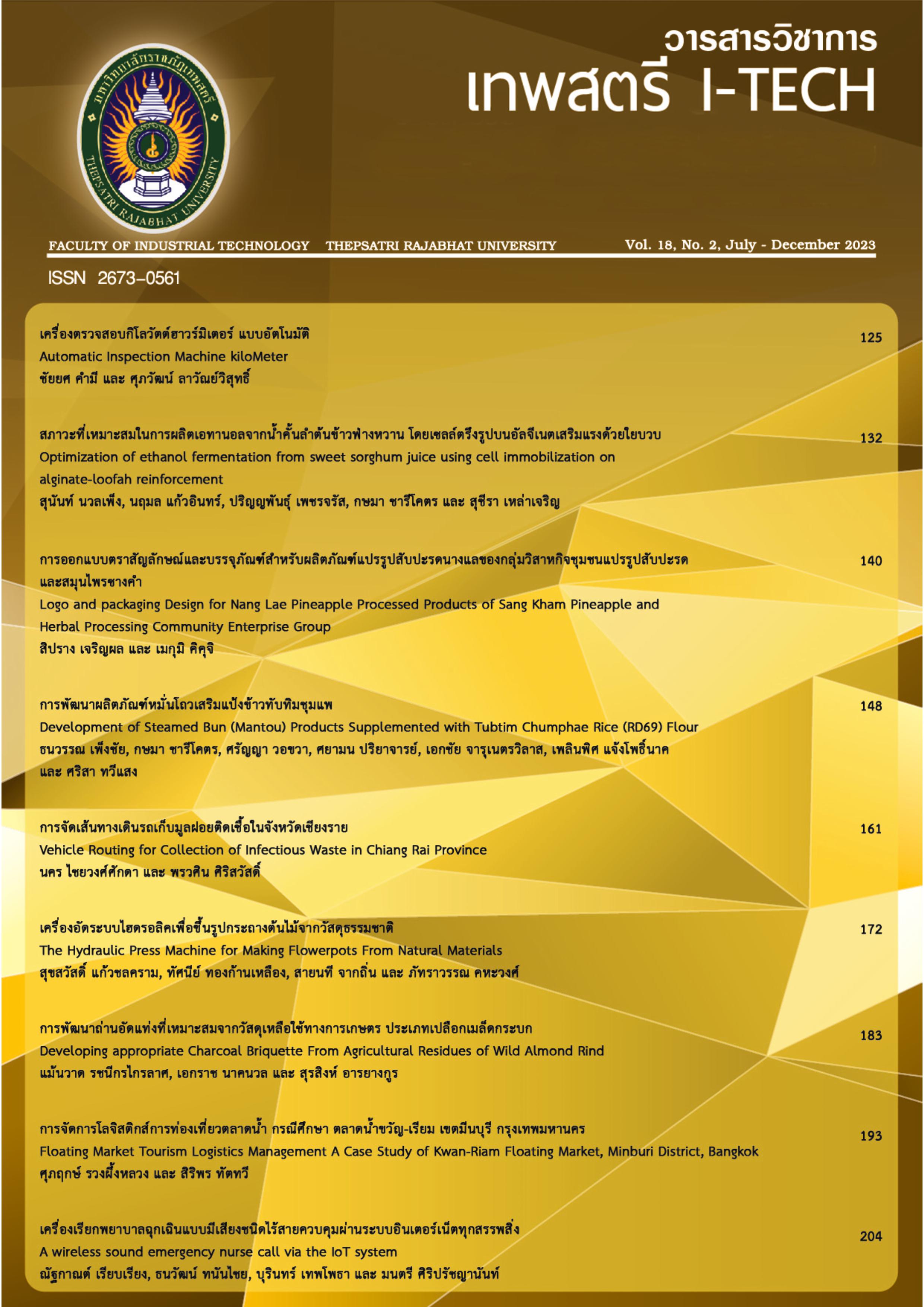สภาวะที่เหมาะสมในการผลิตเอทานอลจากข้าวฟ่างหวาน โดยเซลล์ตรึงรูปบนอัลจีเนตเสริมแรงด้วยใยบวบ
Abstract
วัตถุประสงค์ของการทดลอง เพื่อหาสภาวะที่เหมาะสมในการผลิตเอทานอลจากน้ำคั้นลำต้นข้าวฟ่างหวาน โดยใช้ Saccharomyces cerevisiae TISTR 5048 เซลล์ตรึงรูปบนอัลจีเนตเสริมแรงด้วยใยบวบ โดยวางแผนการทดลองแบบ Box-Benhken design โดยมี 3 ปัจจัยประกอบด้วย ปริมาณเซลล์ตรึง 5, 10 และ 15% (w/v) ความเข้มข้นของน้ำตาลเริ่มต้น 180 240 และ 300 g/L และปริมาณกากเซลล์ยีสต์ 4, 8 และ 12 g/L โดยมีจำนวนเซลล์เริ่มต้น 8.70´106 cells/mL ผลการศึกษาพบว่า ภายใต้สภาวะที่เหมาะสม คือความเข้มข้นของน้ำตาล 280 g/L ต่อ ปริมาณเซลล์ตรึง 5% (w/v) สามารถผลิตเอทานอลได้ 98.84± 0.02 g/L อัตราผลผลิตเอทานอล 1.17± 0.02 g/L.h ระยะเวลาในการหมัก 84 h การศึกษาการผลิตเอทานอลแบบกะซ้ำ ภายใต้สภาวะความเข้มข้นน้ำตาล 280 (g/L) ปริมาณเซลล์ตรึง 5% (w/v) ทำการหมักทั้งหมด 4 กะ ความเข้มข้นเอทานอลสูงสุด และผลผลิตเอทานอลโดยเซลล์ตรึงรูปบนอัลจิเนตภายใต้สภาวะที่เหมาะสม คือ 94.84 ± 2.02 กรัม/ลิตร และ 1.17 ± 0.02 กรัม/ลิตร ตามลำดับ จากผลการศึกษาสามารถสรุปได้ว่าสภาวะที่เหมาะสมต่อการผลิตเอทานอลโดยเซลล์ตรึงรูปบนอัลจิเนตภายใต้สภาวะการหมักแบบกะ คือปริมาณความเข้มข้นน้ำตาล 280 (g/L) และสภาวะที่เหมาะสมต่อการผลิตเอทานอลโดยเซลล์ตรึงรูปบนอัลจิเนตภายใต้สภาวะการหมักแบบกะซ้ำ คือปริมาณน้ำตาลความเข้มข้น 280 (g/L) ปริมาณเซลล์ตรึง 5% (w/v) สามารถผลิตเอทานอลได้ เท่ากับ 98.84± 2.02 g/L และ 1.17 ± 0.02 g/L ตามลำดับ
References
A.E. Farrell, R.J. Plevin, B.T. Turner, A.D. Jones, M. O’Hare and D.M. Kammen, “Ethanol can contribute to energy and environmental goals,” Science, vol. 311, pp. 506–508, 2006.
J. Hill, E. Nelson, D. Tilman, S. Polasky and D. Tiffany, “Environmental, economic, and energetic costs and benefits of biodiesel and ethanol biofuels,” Proc Natl Acad Sci USA. vol. 30, pp.11206–11210, 2006.
J. Yan and Lin T, “Biofuels in Asia,” Appl Energy, vol. 86, Vol. S1–S10, 2009.
L. Laopaiboon, S. Nuanpeng, P. Srinophakun, P. Klanrit and P. Laopaiboon, “Ethanol production from sweet sorghum juice using very high gravity technology: effects of carbon and nitrogen supplementations,” Bioresour Technol, vol. 18, pp. 4176–4182, 2009.
S. Nuanpeng, S. Thanonkeo, M. Yamada and P. Thanonkeo, “Ethanol production from sweet sorghum juice at high temperature using a newly isolated thermotolerant yeast Saccharomyces cerevisiae DBKKU Y-53,” Energies, vol. 9, pp. 253-273, 2016.
S. Nuanpeng, L. Laopaiboon, P. Srinophakun, P. Klanrit, P. Jaisil and P. Laopaiboon, “Ethanol production from sweet sorghum juice under very high gravity conditions: batch, repeated-batch and scale up fermentation,” Electron J Biotechnol, vol. 14, pp.1–12, 2011.
L. Wang, Z. Luo and A. Shahbazi, “Optimization of simultaneous saccharification and fermentation for the production of ethanol from sweet sorghum (Sorghum bicolor) bagasse using response surface methodology,” Ind Crops Prod., vol. 42, pp.280–291, 2013.
F. Shen, Y. Zeng, S. Deng, and R. Liu, “Bioethanol production from sweet sorghum stalk juice with immobilized yeast,” Process Environ Sci, vol. 11, pp.782–789, 2011.
Y. Kourkoutas, A. Bekatorou, I.M. Banat, R. Marchant and A.A. Koutinas, “Immobilization technologies and support materials suitable in alcohol beverages production: a review,” Food Microbiol, vol. 21, pp.377–397, 2004.
G. Najafpour, H. Younesi and K.S.K. Ismail, “Ethanol fermentation in an immobilized cell reactor using Saccharomyces cerevisiae,” Bioresour Technol, vol. 92, pp. 251–260, 2004.
M. Phisalaphong, R. Budiraharjo, P. Bangrak, J. Mongkolkajit, and S. Limtong, “Alginate-loofa as carrier matrix for ethanol production,” J Biosci Bioeng, Vol. 104, pp. 214–217, 2007.
F. Ghorbani, H. Younesi, A.E. Sari, G. Najafpour,
“Cane molasses fermentation for continuous ethanol production in an immobilized cells reactor by Saccharomyces cerevisiae,” Renew Energy, vol. 36, pp. 503–509, 2011.
P. Bangrak, S. Limtong and M. Phisalaphong, “Continuous ethanol production using immobilized yeast cells entrapped in loofa-reinforced alginate carriers,” Braz J Microbiol, vol. 42, pp.676–684, 2011.
S. Behera, R.C. Mohanty and R.C. Ray, “Ethanol production from mahula (Madhuca latifolia L.) flowers with immobilized cells of Saccharomyces cerevisiae in Luffa cylindrica L. sponge discs,” Appl Energy, vol. 88, pp. 212–215, 2011.
J.C. Ogbonna, Y.C. Liu, Y.K. Liu and H. Tanaka, “Loofa (Luffa cylindrica) sponge as a carrier for microbial cell immobilization,” J Ferment Bioeng, vol. 78, pp. 437–442, 1994.
I.O. Mazali and O.L. Alves, “Morphosynthesis: high fidelity inorganic replica of the fibrous network of loofa sponge (Luffa cylindrical),” Ann Braz Acad Sci, vol. 77, pp. 25–31, 2005.
R. Ganguly, P. Dwivedi and R.P. Singh, “Production of lactic acid with loofa sponge immobilized Rhizopus oryzae RBU2-10,” Bioresour Technol, vol. 98, pp. 1246–1251, 2007.
J.C. Ogbonna, J. Mashima and H. Tanaka, “Scale up of fuel ethanol production from sugar beet juice using loofa sponge immobilized bioreactor,” Bioresour Technol, vol. 76, pp. 1–8, 2001.
A. Eiadpum, S. Limtong and M. Phisalaphong, “High-temperature ethanol fermentation by immobilized coculture of Kluyveromyces marxianus and Saccharomyces cerevisiae,” J Biosci Bioeng, vol. 3, pp. 325–329, 2012.
L. Laopaiboon, P. Thanonkeo, P, Jaisil and P. Laopaiboon, “Ethanol production from sweet sorghum juice in batch and fed-batch fermentations by Saccharomyces cerevisiae,” World J Microbiol Biotechnol, vol. 23, pp. 1497–1501, 2007.
W. Sridee, L. Laopaiboon, P. Jaisil and· P. Laopaiboon, “The use of dried spent yeast as a low-cost nitrogen supplement in ethanol fermentation from sweet sorghum juice under very high gravity conditions,” Electron. J. Biotechnol., vol. 14, 2011.
A. Rattanapan, S. Limtong and M. Phisalaphong, “Ethanol production by repeated batch and continuous fermentations of blackstrap molasses using immobilized yeast cells on thin-shell silk cocoons,” Appl Energy., vol. 88, pp. 4400–4404, 2012.

